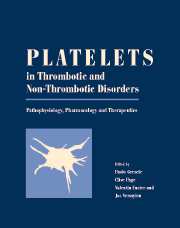Book contents
- Frontmatter
- Contents
- List of contributors
- Editors' preface
- PART I PHYSIOLOGY
- PART II METHODOLOGY
- PART III PATHOLOGY
- 34 Hereditary thrombocytopenias
- 35 Thrombocytopenias due to bone marrow disorders
- 36 Immune-mediated thrombocytopenia
- 37 Thrombocytopenia in childhood
- 38 Alloimmune thrombocytopenia
- 39 Drug-induced and drug-dependent immune thrombocytopenias
- 40 Thrombotic thrombocytopenic purpura and hemolytic uremic syndrome
- 41 Thrombocytosis and thrombocythemia
- 42 Platelet adhesive protein defect disorders
- 43 Congenital disorders of platelet secretion
- 44 Congenital platelet signal transduction defects
- 45 Acquired platelet function defects
- 46 Platelet storage and transfusion
- 47 Pathophysiology of arterial thrombosis
- 48 Platelets and atherosclerosis
- 49 Platelet involvement in venous thrombosis and pulmonary embolism
- 50 Gene regulation of platelet function
- 51 Platelets and bacterial infections
- 52 Interactions of viruses and platelets and the inactivation of viruses in platelet concentrates prepared for transfusion
- 53 Platelets and parasites
- 54 Platelets and tumours
- 55 Platelets and renal diseases
- 56 Platelets and allergic diseases
- 57 Platelet interactions with other cells related to inflammatory diseases
- 58 Platelets and the preimplantation stage of embryo development
- 59 Platelets in psychiatric and neurological disorders
- 60 Platelets in inflammatory bowel disease
- PART IV PHARMOLOGY
- PART V THERAPY
- Afterword: Platelets: a personal story
- Index
- Plate section
37 - Thrombocytopenia in childhood
from PART III - PATHOLOGY
Published online by Cambridge University Press: 10 May 2010
- Frontmatter
- Contents
- List of contributors
- Editors' preface
- PART I PHYSIOLOGY
- PART II METHODOLOGY
- PART III PATHOLOGY
- 34 Hereditary thrombocytopenias
- 35 Thrombocytopenias due to bone marrow disorders
- 36 Immune-mediated thrombocytopenia
- 37 Thrombocytopenia in childhood
- 38 Alloimmune thrombocytopenia
- 39 Drug-induced and drug-dependent immune thrombocytopenias
- 40 Thrombotic thrombocytopenic purpura and hemolytic uremic syndrome
- 41 Thrombocytosis and thrombocythemia
- 42 Platelet adhesive protein defect disorders
- 43 Congenital disorders of platelet secretion
- 44 Congenital platelet signal transduction defects
- 45 Acquired platelet function defects
- 46 Platelet storage and transfusion
- 47 Pathophysiology of arterial thrombosis
- 48 Platelets and atherosclerosis
- 49 Platelet involvement in venous thrombosis and pulmonary embolism
- 50 Gene regulation of platelet function
- 51 Platelets and bacterial infections
- 52 Interactions of viruses and platelets and the inactivation of viruses in platelet concentrates prepared for transfusion
- 53 Platelets and parasites
- 54 Platelets and tumours
- 55 Platelets and renal diseases
- 56 Platelets and allergic diseases
- 57 Platelet interactions with other cells related to inflammatory diseases
- 58 Platelets and the preimplantation stage of embryo development
- 59 Platelets in psychiatric and neurological disorders
- 60 Platelets in inflammatory bowel disease
- PART IV PHARMOLOGY
- PART V THERAPY
- Afterword: Platelets: a personal story
- Index
- Plate section
Summary
Thrombocytopenia in children as in adults has a pleiomorphic expression, which may vary from a life-threatening hemorrhagic accident, to a biological finding in an apparently healthy child. In many patients clinical expression is absent or mild and thrombocytopenia will be fortuitously detected by blood cell counts during the course of a disease or prior to surgery. Neonatal thrombocytopenias also have special features requiring special diagnostic approach and management.
Platelet counting by blood cell automatic counters usually is reliable. However, in some situations, platelet counting can be erroneous; for example, circulating particles whose volume is within the platelet volume range can spuriously increase the platelet count and mask a thrombocytopenia; this can occur with extreme microcytosis or red cell fragmentation. On the contrary, in vitro platelet consumption, due to hemostasis activation during sampling or inefficient anticoagulation of the sample or to EDTA-induced platelet aggregation, can lead to spurious thrombocytopenia. In any case, an initial diagnosis of thrombocytopenia must be verified by phase contrast microscopy after microsampling, and by examination of the platelets' size, morphology and density on blood smears. There is no close correlation between clinical presentation and platelet count. Most patients will have minimal bleeding symptoms even with platelet counts below 50 × 109/l. Others can exhibit bruising and bleeding in spite of moderate thrombocytopenia due to associated platelet functional abnormalities. The search for a precise etiology, which can be either constitutional or acquired, needs a rigorous approach, as therapeutic decisions have to rely on certainties (Table 37.1).
In this chapter drug-induced thrombocytopenia and thrombocytopenia associated with malignancies will not be considered.
- Type
- Chapter
- Information
- Platelets in Thrombotic and Non-Thrombotic DisordersPathophysiology, Pharmacology and Therapeutics, pp. 556 - 568Publisher: Cambridge University PressPrint publication year: 2002
- 1
- Cited by



